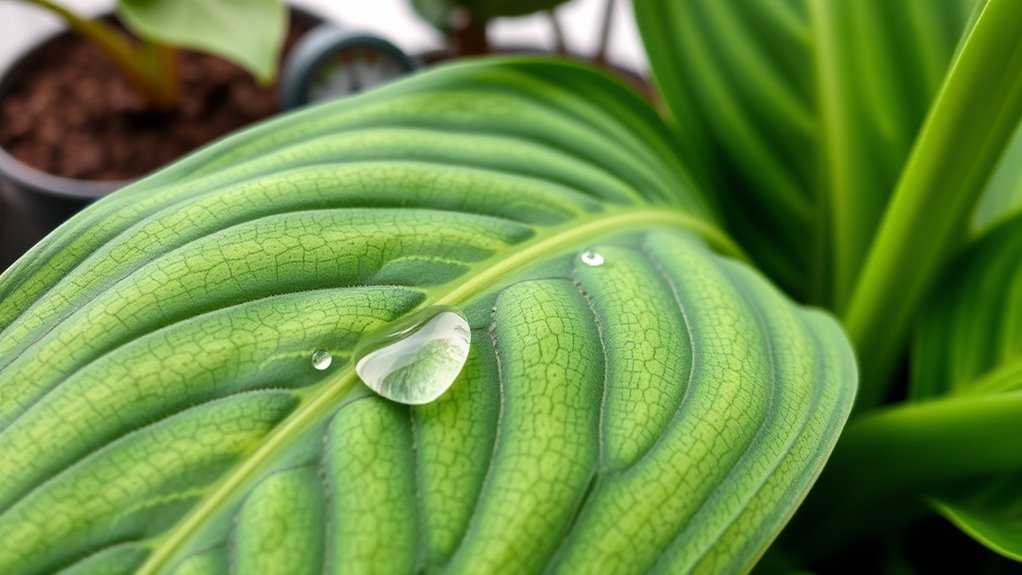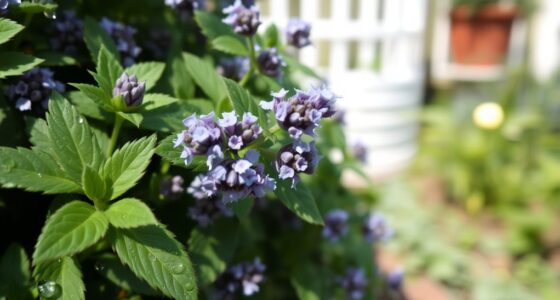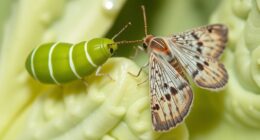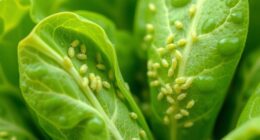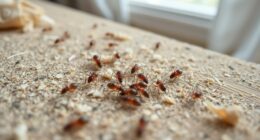If your Calathea Warscewiczii is drooping, start by checking the humidity levels—aim for consistent moisture around 50-60%, since low or fluctuating humidity causes the leaves to wilt. Also, test your soil moisture; it should be slightly moist but not waterlogged to prevent root rot. Improving humidity with misting or trays and adjusting soil drainage can help. Keep an eye on these factors, and you’ll find more tips to revive your plant if you keep exploring.
Key Takeaways
- Check if humidity levels are too low; increase humidity with misting, humidifiers, or pebble trays.
- Regularly monitor soil moisture, ensuring the top inch remains slightly moist without waterlogging.
- Use well-draining, aerated soil with proper composition to prevent overwatering and root issues.
- Maintain consistent watering and fertilization routines to support plant resilience and prevent drooping.
- Ensure proper drainage and soil health to promote vibrant foliage and reduce stress-induced drooping.
Recognizing the Signs of Drooping in Your Calathea Warscewiczii
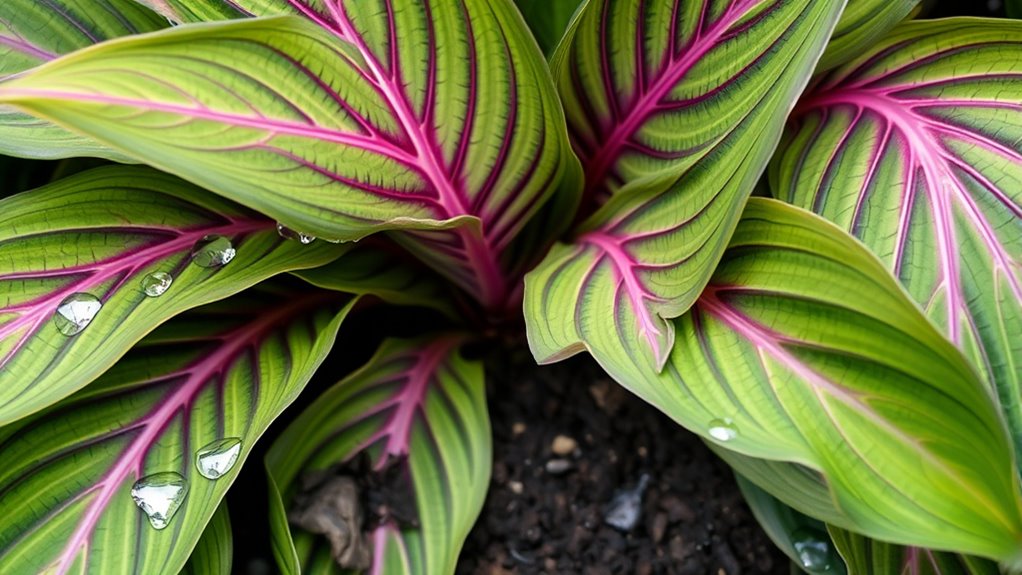
When your Calathea Warscewiczii starts to droop, it’s a clear sign that something’s wrong. You should check for signs of improper fertilizer application, like yellowing leaves or stunted growth, which can weaken the plant and cause drooping. Additionally, inspect for pests such as spider mites or mealybugs, as their presence can stress the plant and lead to wilting. Consistent watering isn’t enough if pests are present or if fertilizer isn’t balanced; both can affect your plant’s health. Address these issues promptly by adjusting your fertilizer routine and performing pest control measures. Recognizing these early signs helps you take swift action to restore your Calathea’s robustness and prevent further drooping. Monitoring soil health also plays a vital role in maintaining your plant’s vitality and avoiding drooping issues.
Assessing and Adjusting Humidity Levels for Optimal Growth
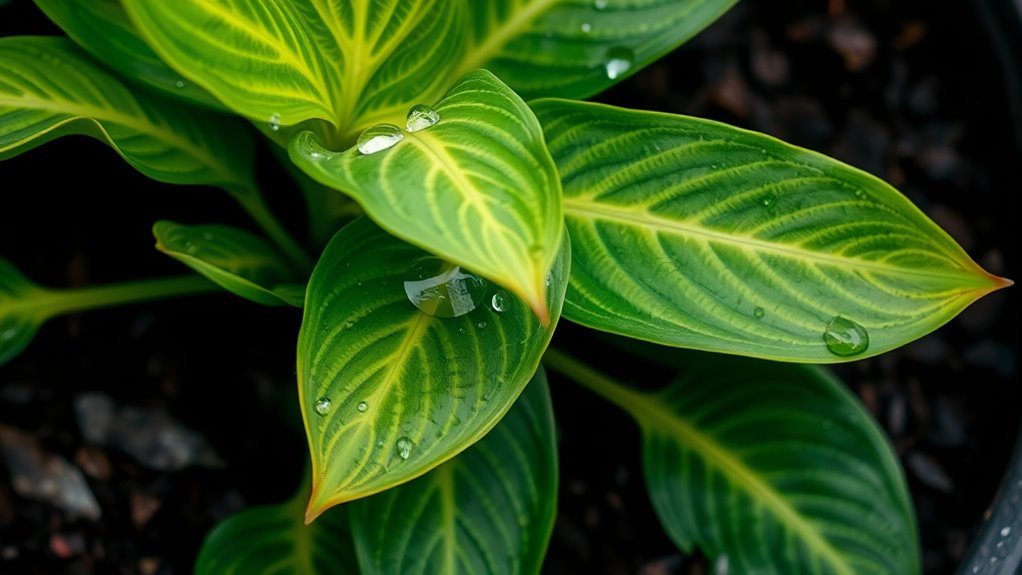
Drooping in your Calathea Warscewiczii can often be linked to humidity levels that are too low or inconsistent. To improve leaf color and prevent further drooping, you should assess your humidity environment regularly. Increase humidity by misting the plant, using a humidifier, or grouping it with other plants. Also, consider the pot size; a larger pot can hold more moisture and stabilize humidity around the roots. Use the following table to evaluate your setup:
| Humidity Level | Effect on Leaf Color | Pot Size Impact |
|---|---|---|
| Low | Yellowing, dull | Smaller pots dry out faster |
| Moderate | Vibrant, healthy | Larger pots retain more moisture |
| High | Lush, bright green | Proper sizing maintains humidity |
Adjust accordingly to keep your Calathea thriving. Additionally, be aware that pinball machines vary significantly in weight, which can influence how you handle and position your plant if you plan to move it. Regularly monitoring humidity levels can help you maintain an optimal environment for your Calathea. Having a humidity meter can provide accurate readings to fine-tune your adjustments.
Checking Soil Moisture and Drainage Conditions
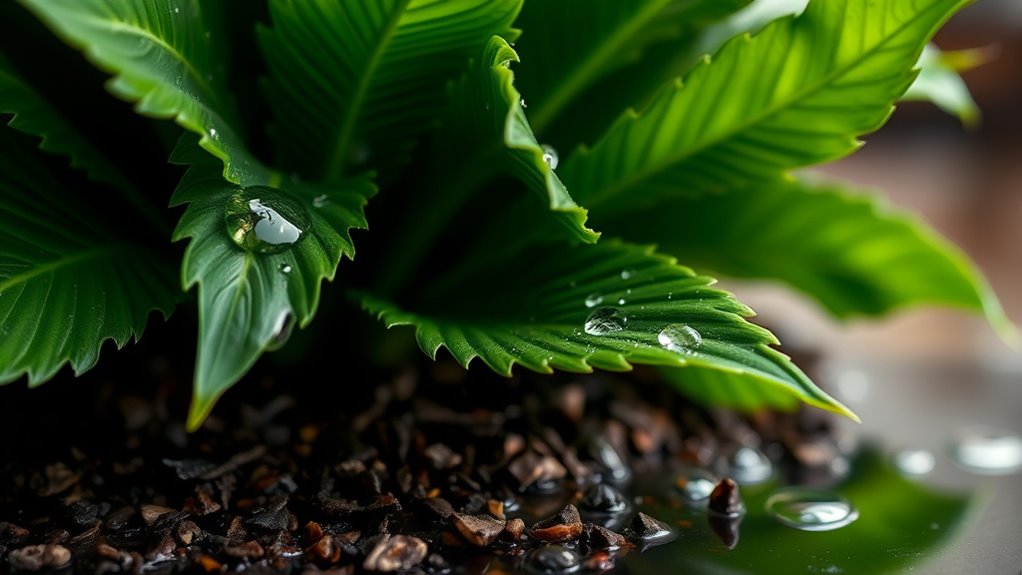
To keep your Calathea Warscewiczii healthy, you need to regularly check its soil moisture levels and guarantee proper drainage. Use your finger or a moisture meter to monitor how wet or dry the soil is, and observe how quickly excess water drains away. If needed, adjust the soil composition to improve drainage and prevent water from pooling around the roots. Being aware of your plant’s regional climate can also help you optimize its care and prevent issues like overwatering or drought stress. Proper watering techniques are essential to avoid problems such as root rot and dehydration. Monitoring for symptoms of overwatering, such as yellowing leaves or root rot, can help you catch problems early and maintain a healthy plant environment.
Moisture Level Monitoring
Monitoring soil moisture levels is essential to prevent Calathea warscewiczii from drooping due to over or under-watering. When soil stays too wet, it increases the risk of root rot, weakening the plant’s roots and causing droopiness. Conversely, soil that’s too dry stresses the plant, leading to wilting. Use your finger or a moisture meter to check soil dampness regularly; the top inch should be slightly moist but not soggy. Consistently overwatering can also attract pest infestation, which worsens health issues. Ensuring proper moisture balance helps maintain healthy roots and prevents drooping. Adjust watering habits accordingly, allowing the soil to dry slightly between waterings. Proper moisture monitoring safeguards your plant’s crucial and prevents problems like root rot and pest infestation. Regularly inspecting soil drainage conditions helps prevent waterlogging, which is vital for healthy Calathea growth.
Drainage System Effectiveness
Ensuring your Calathea Warscewiczii’s drainage system works effectively is key to maintaining proper soil moisture levels. Poor drainage can lead to waterlogged soil, increasing the risk of root rot and attracting pest infestations. To check this, lift the plant occasionally and observe how quickly excess water drains. If water stands in the pot’s bottom or drains slowly, improve your drainage system. Use pots with drainage holes and a layer of gravel or coarse material at the bottom. Consistent poor drainage allows moisture to linger, harming roots and inviting pests like fungus gnats. Regularly inspect the drainage area to prevent buildup and guarantee excess water escapes freely. Proper drainage helps keep your Calathea healthy, vibrant, and free from moisture-related issues.
Soil Composition Adjustment
Regularly checking your Calathea Warscewiczii’s soil moisture helps you determine if the soil has the right balance. If it’s too wet or dry, adjust your soil composition accordingly. Well-draining soil prevents overwatering, reducing the risk of root rot and pest problems. Incorporate organic matter or perlite to improve drainage. For ideal growth, apply fertilizer appropriately, ensuring nutrients reach the roots without excess moisture. Proper soil structure is essential for maintaining consistent moisture levels and supporting healthy roots. Here’s a quick guide:
| Soil Condition | Adjustment Tips |
|---|---|
| Too moist | Add sand or perlite for drainage |
| Too dry | Mix in peat or organic compost |
| Poor drainage | Use a pot with drainage holes |
| Nutrient deficiency | Fertilize lightly during active growth |
| Risk of pests | Maintain dry surface to prevent pests |
Balancing soil moisture enhances plant health and prevents drooping. Additionally, understanding soil composition helps you optimize conditions for healthy growth.
Improving Humidity Through Practical Methods
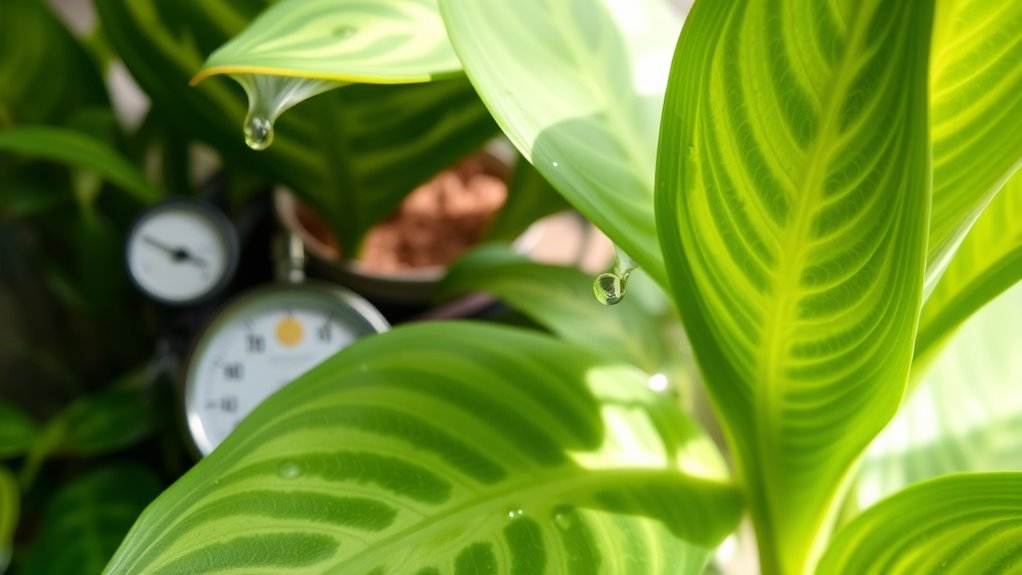
To prevent Calathea warscewiczii from drooping due to low humidity, you can take practical steps to boost moisture levels around your plant. Implementing humidity control methods, like grouping plants together or placing a humidifier nearby, creates a more favorable environment. Regularly misting the leaves also helps, but avoid overdoing it to prevent fungal issues. Using a pebble tray filled with water beneath the pot can increase local humidity without risking waterlogging. Additionally, maintaining ideal plant nutrition supports healthy leaf turgor, making your plant more resilient to dry conditions. Monitoring humidity levels and humidifier settings ensures you can adjust your methods as needed, keeping your Calathea happy and vibrant. Understanding plant hydration needs is essential for optimal care. Staying attentive to the humidity levels in your environment can significantly improve your plant’s health. These simple actions greatly reduce drooping caused by dry air.
Selecting and Preparing the Right Soil Mix
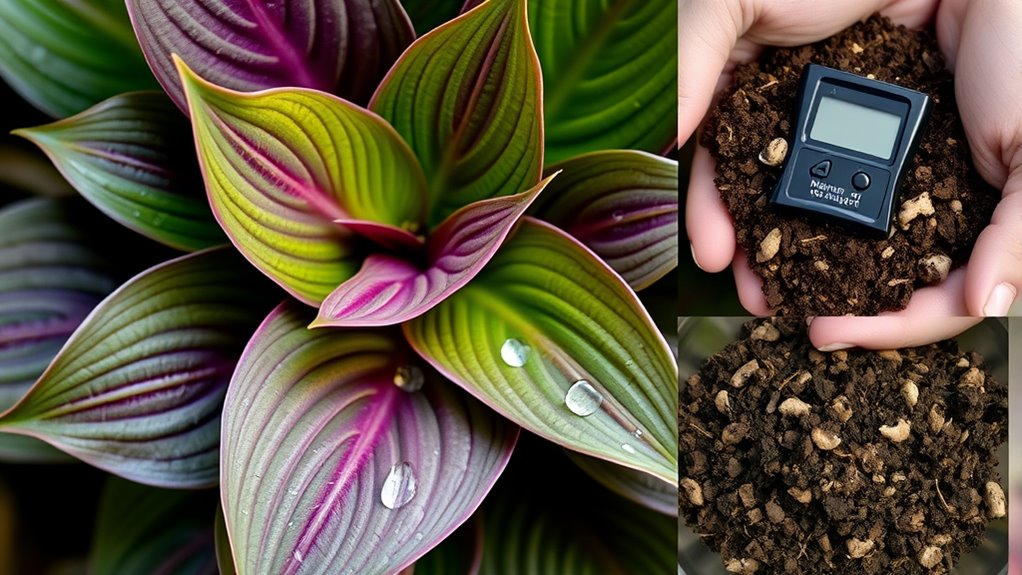
Choosing the right soil mix is essential for your Calathea warscewiczii to thrive. You want a well-draining, aerated blend that retains moisture without becoming waterlogged. Use a mix of peat moss, perlite, and potting soil to achieve this balance. Proper soil prevents pests, as damp, stagnant conditions invite unwanted visitors. Before planting, confirm the soil is fresh and free of pathogens. Incorporate gentle fertilizer application into your routine to promote healthy growth, but avoid overdoing it, as excess nutrients can harm the plant. Regularly check the soil’s moisture level and adjust watering accordingly. Selecting and preparing the right soil mix creates a strong foundation, reduces pest risks, and supports your Calathea’s overall health and vibrant foliage. Additionally, ensuring the soil is free from dampness or stagnation helps maintain optimal humidity levels and prevents drooping. Using a soil that maintains the proper balance of moisture and aeration is crucial for healthy root development and preventing issues like root rot.
Maintaining Consistent Care for a Thriving Calathea
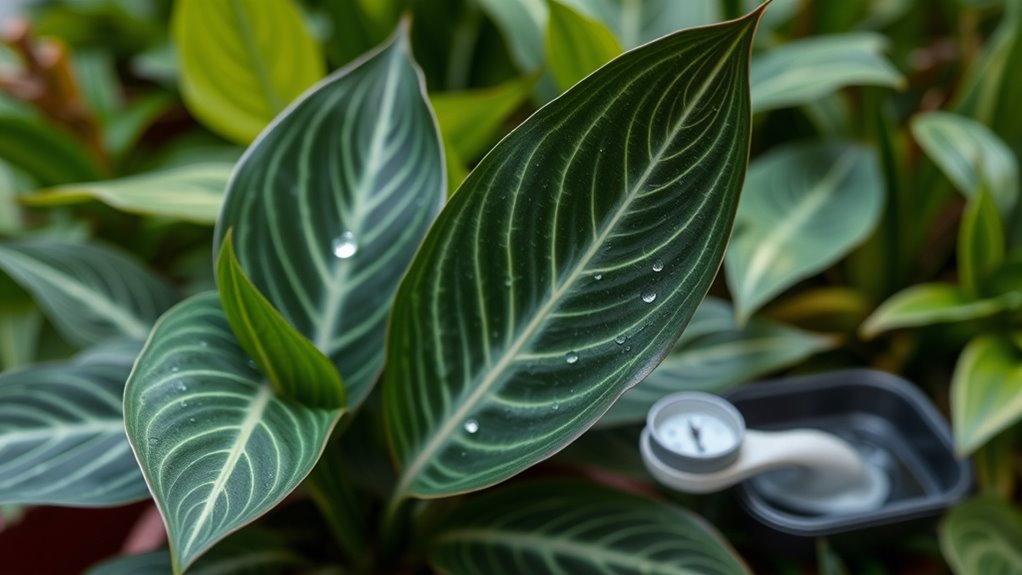
Maintaining consistent care is key to keeping your Calathea warscewiczii healthy and vibrant. Regular pruning techniques help remove dead or yellowing leaves, encouraging new growth and improving airflow. Use clean, sharp scissors or pruning shears to prevent disease. Establish a steady fertilizer schedule, feeding every 4-6 weeks during the growing season with a balanced, water-soluble fertilizer diluted to half strength. Avoid over-fertilizing, which can cause leaf burn or drooping. Keep your watering routine consistent, maintaining moist soil without waterlogging. Monitor humidity levels regularly and adjust as needed. Consistency in light, watering, and feeding routines ensures your Calathea stays healthy, lively, and less prone to drooping or other issues. Additionally, sound recording techniques can be employed to document and analyze your plant’s growth patterns, providing valuable insights into optimal care conditions.
Frequently Asked Questions
Can Temperature Fluctuations Cause Calathea Warscewiczii Drooping?
Yes, temperature fluctuations can cause your Calathea Warscewiczii to droop by affecting its leaf turgor. When temperatures aren’t stable, your plant struggles to maintain proper water balance, leading to drooping leaves. To keep it healthy, guarantee consistent temperatures and avoid drafts or sudden changes. Stable conditions help preserve leaf turgor, making your plant look vibrant and firm. Regular checks and maintaining a steady environment are key.
How Does Light Exposure Affect Drooping Symptoms?
Think of your Calathea Warscewiczii like a sunflower turning toward the sun. Light exposure affects drooping symptoms by influencing leaf positioning; too much direct light causes leaves to curl or wilt, while too little results in drooping from insufficient energy. You notice the plant’s leaves adjusting with changes in light intensity, helping you find the perfect balance for vibrant, upright foliage and healthier growth.
Are Fertilizer Overfeeding Issues Linked to Drooping?
Fertilizer overfeeding can lead to drooping by causing root damage, which hampers your plant’s ability to absorb water and nutrients. Too much fertilizer creates salt buildup in the soil, stressing the roots and making the leaves limp and droopy. To prevent this, you should follow recommended feeding schedules, flush excess fertilizer regularly, and guarantee your Calathea gets balanced nutrients without risking root damage.
What Are Common Pests That Cause Leaf Drooping?
Did you know that pests cause over 20% of plant diseases worldwide? When your Calathea’s leaves droop, pests like spider mites, aphids, or mealybugs might be to blame. These pests feed on plant sap, leading to leaf discoloration and weakening your plant’s structure. Regularly inspect your plant for tiny bugs or webbing, and treat infestations promptly to restore your plant’s health and prevent further leaf drooping.
How Often Should I Repot My Calathea Warscewiczii?
You should repot your Calathea Warscewiczii every 1-2 years, or when it outgrows its current pot. A proper repotting schedule helps maintain soil nutrient balance and promotes healthy growth. Look for signs like roots becoming root-bound or soil draining poorly. During repotting, refresh the soil with a well-draining mix, and avoid disturbing the roots too much to guarantee your plant stays happy and vibrant.
Conclusion
By paying close attention to your Calathea Warscewiczii’s needs, you hold the key to its vibrant health. Keep humidity and soil moisture in check—think of them as the heartbeat of your plant’s happiness. When you nurture these elements, you’re not just caring for a plant; you’re cultivating a living masterpiece. Remember, a thriving Calathea isn’t just a plant—it’s a proof to your attentive, loving care.
